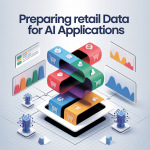
Practical Applications and Hands-On Training”
The goal of this module is to equip learners with real-world skills by engaging them in hands-on projects where they will analyze sample data sets, create inventory forecasts, and develop personalized marketing strategies.
These projects will enable participants to apply theoretical knowledge, refine their analytical skills, and better understand how data analytics impacts key aspects of retail operations.
1. Overview of Hands-On Projects
Hands-on projects are a crucial element in learning how to use data analytics effectively.
By engaging in practical tasks, learners can translate theoretical knowledge into actionable skills. In this module, learners will:
- Analyze Sample Data Sets to gain familiarity with common data structures, recognize trends, and identify key insights that can inform business decisions.
- Create Inventory Forecasts using historical data to predict future stock needs, helping to align supply with customer demand and reduce both stockouts and excess inventory.
- Develop Personalized Marketing Strategies based on customer data, allowing participants to design targeted marketing campaigns that resonate with specific customer segments.
The module is structured to gradually increase in complexity, allowing learners to build foundational skills before moving on to more advanced tasks.
2. Analyzing Sample Data Sets
2.1 Importance of Analyzing Data in Retail
In retail, analyzing data is the foundation of informed decision-making.
By understanding customer behavior, sales patterns, and market trends, businesses can optimize operations, enhance customer satisfaction, and increase profitability.
The ability to clean, organize, and analyze data is therefore a critical skill for anyone involved in retail analytics.
2.2 Objectives of the Hands-On Project
-
Objective 1: Data Cleaning and Preparation
- Learners will be provided with raw data sets containing sales, inventory, and customer data. Their first task will be to clean the data by removing inconsistencies, handling missing values, and formatting the data for analysis.
- Skills Developed: Data cleaning, data wrangling, handling missing values, ensuring data integrity.
-
Objective 2: Exploratory Data Analysis (EDA)
- Once the data is clean, learners will perform exploratory data analysis to identify trends and patterns. This includes examining sales over time, understanding which products are selling the most, and identifying customer segments.
- Skills Developed: Visualization techniques, summarizing data, identifying key trends, using statistical methods to interpret data.
-
Objective 3: Extracting Insights
- Based on the exploratory analysis, learners will identify actionable insights that can inform business decisions. For instance, they might discover that certain products are consistently understocked, or that certain customer segments respond better to specific promotions.
- Skills Developed: Insight extraction, translating data into business recommendations, making data-driven decisions.
2.3 Tools and Software
For this project, learners will use industry-standard tools such as:
- Microsoft Excel: For basic data manipulation, cleaning, and initial analysis.
- Python (with Pandas and Matplotlib): For advanced data wrangling, visualization, and analysis.
- Tableau or Power BI: For creating dashboards that visually represent key insights from the data.
3. Creating Inventory Forecasts
3.1 Importance of Inventory Forecasting
Inventory forecasting is essential for aligning stock levels with customer demand.
Poor forecasting can lead to stockouts, which result in lost sales, or excess inventory, which ties up capital and increases holding costs.
Accurate forecasting ensures that the right products are available at the right time, improving both operational efficiency and customer satisfaction.
3.2 Objectives of the Hands-On Project
-
Objective 1: Understanding Historical Data
- Learners will analyze historical sales and inventory data to understand demand patterns. This includes identifying seasonal trends, product life cycles, and other external factors that influence demand.
- Skills Developed: Identifying trends, understanding seasonality, analyzing sales data in context.
-
Objective 2: Time Series Forecasting
- Using the historical data, learners will apply time series analysis to forecast future demand. They will use techniques such as moving averages, exponential smoothing, and ARIMA (AutoRegressive Integrated Moving Average) models to make predictions.
- Skills Developed: Time series analysis, using statistical forecasting methods, understanding forecasting accuracy metrics.
-
Objective 3: Creating a Forecasting Model
- Learners will build a forecasting model that predicts demand for a specific product category over the next 6-12 months. They will adjust the model based on external variables, such as marketing campaigns or economic factors, to improve accuracy.
- Skills Developed: Model creation, refining predictions, incorporating external variables into forecasts.
3.3 Tools and Software
For this project, learners will use the following tools:
- Python (with Pandas and Statsmodels): For time series analysis and forecasting.
- Excel: For simple moving averages and forecasting using built-in functions.
- R (optional): For advanced statistical forecasting models.
4. Developing Personalized Marketing Strategies
4.1 Importance of Personalized Marketing
Personalized marketing is the key to engaging modern consumers, who expect brands to tailor their messaging and offers to individual preferences.
By using customer data to segment audiences and craft personalized marketing campaigns, businesses can improve conversion rates, increase customer loyalty, and enhance the overall customer experience.
4.2 Objectives of the Hands-On Project
-
Objective 1: Customer Segmentation
- Learners will use customer data to segment the audience based on demographics, purchasing behavior, and preferences. They will create distinct customer personas that represent each segment.
- Skills Developed: Data segmentation, persona development, identifying key characteristics of customer groups.
-
Objective 2: Personalization Techniques
- Learners will develop personalized marketing strategies for each customer segment, using techniques such as personalized email campaigns, targeted ads, and product recommendations.
- Skills Developed: Designing personalized marketing content, using customer data to inform messaging, developing campaign strategies.
-
Objective 3: Campaign Performance Metrics
- Learners will set KPIs (Key Performance Indicators) to measure the effectiveness of their personalized marketing campaigns. Metrics such as click-through rates, conversion rates, and customer lifetime value (CLV) will be used to evaluate success.
- Skills Developed: Setting KPIs, measuring campaign effectiveness, using analytics to refine marketing strategies.
4.3 Tools and Software
For this project, learners will use tools that facilitate personalized marketing campaigns, including:
- Google Analytics: For tracking customer behavior and engagement.
- CRM Platforms (e.g., HubSpot or Salesforce): For managing customer data and designing targeted campaigns.
- Mailchimp or similar: For executing personalized email campaigns and measuring their success.
5. Evaluation and Feedback
At the end of this lesson, learners will submit their completed projects for evaluation. Each project will be assessed based on the following criteria:
- Data Analysis: The quality and depth of the data analysis, including how well learners identify key trends and insights from the sample data sets.
- Forecasting Accuracy: The accuracy of the inventory forecasts and the learner’s ability to justify their forecasting methods.
- Marketing Strategy Effectiveness: The creativity and practicality of the personalized marketing strategies developed, as well as the effectiveness of the KPIs chosen to measure campaign success.
Learners will receive personalized feedback to help them refine their analytical and strategic thinking.
Peer review sessions may also be included to allow learners to exchange ideas and gain new perspectives.
6. Conclusion
Hands-On Training is designed to give learners real-world experience in applying data analytics to key aspects of retail operations.
By analyzing sample data sets, creating inventory forecasts, and developing personalized marketing strategies, participants will gain a deeper understanding of how data can drive decision-making and improve business performance.
This hands-on approach will equip learners with the skills they need to succeed in roles related to inventory management, marketing, and data analytics in the retail sector.


